說到 Golang,總會提到其高併發的特性,而 goroutine 則是撐起 Golang 高併發的基礎。本文試著比較 Java thread 和 Golng goroutine 在 OS 運行的方式,讓大家能理解 goroutine 在設計上的獨到之處。
# Java Thread
Java thread 直接使用 OS 提供的 native thread,即是每一個 Java thread 都是對應 OS 的 thread,完全依賴 OS 去排程調度:
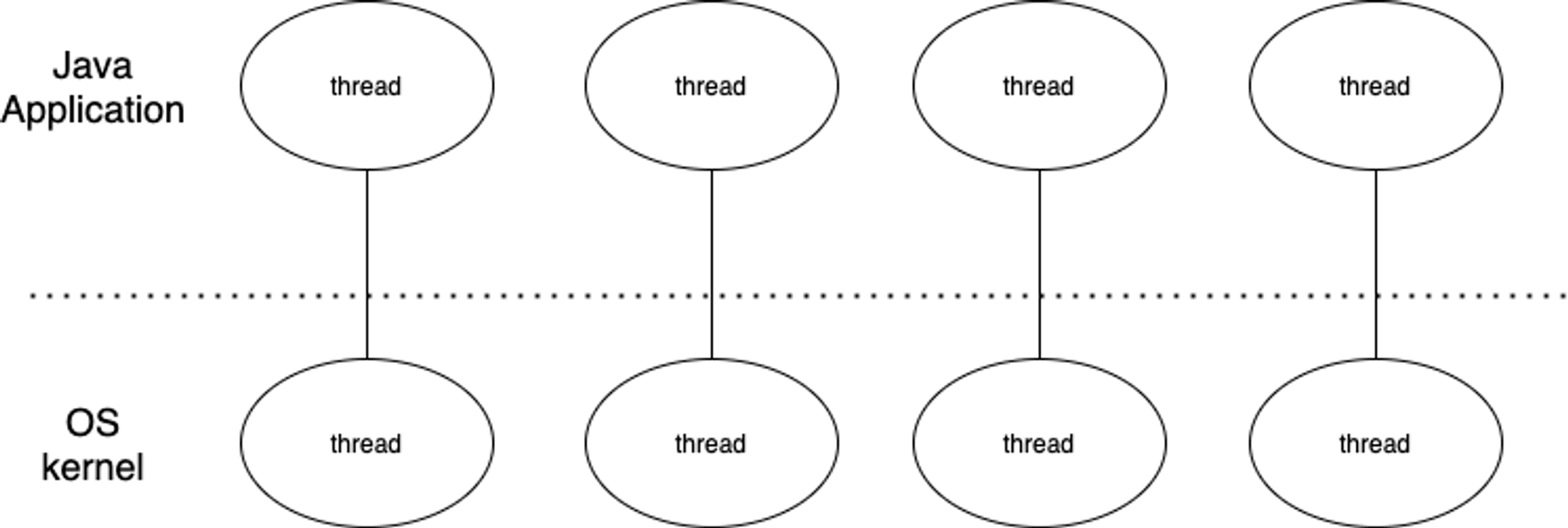
下面是一段簡單的 Java code,內容是創建 1000 個 thread:
public static void main(String []args) throws InterruptedException {
for (int i = 0 ;i<1000;i++){
new Thread(()->{
try {
Thread.sleep(100000000);
} catch (InterruptedException e) {
e.printStackTrace();
}
}).start();
}
Thread.sleep(100000000);
}當你在 linux 上跑起來用 ps 指令觀察 java 程序,可以看到該程序使用了 1018 個 thread (其中 18 個為 jvm 本身系統使用的 thread,例如 GC 之類的)。
**g7@g7test1**:**~**$ ps -T 102763 | wc -l
1018但隨著時代演進,曾經被稱為 lightweight process 的 thread,也逐漸無法應付高併發的場景。
# 原生 Thread 的問題
- 記憶體
Java 每創建一個 thread 都會分配一個固定的 memory 作為 stack 使用。也就是 OS 的記憶體和 SWAP 空間會限制 Java Application 創建 thread 的數量上限,即便 Java Application 實際上沒用到這麼多記憶體。
另外你可以在啟動 Java 時用 -Xss 指令指定 thread 佔用的記憶體大小,但實際上太小也會導致 Jvm 無法啟動。像我的筆電指定記憶體小於 135k 就會出錯。 - 創建 thread 和 Context Switch 的開銷
當 thread 數量超過 core 數量的時候,OS 會透過排程盡可能讓每個 thread 都能公平的佔用 core,而 core 把執行到一半的 thread 狀態存起來,切換到另一個 thread 執行就是 Context Switch。
context switch 本身也是會佔用 core 運算資源的。當 thread 數量過多時,會造成 core 花在創建/銷毀 thread 和 Context Switch上的比例變多,變相減少 throughput。
下這是一段段用 ExecutorService 的 thread pool 執行 200000 次 doSomething function 的 java code,用來實驗 thread 的開銷有多昂貴:
public static void doSomething(){
for (int j = 0; j < 1000; j++) {
Random random = new Random();
int anInt = random.nextInt();
}
}
public static void main(String []args) throws InterruptedException {
int threadNum = Integer.parseInt(args[0]);
ExecutorService executorService = Executors.newFixedThreadPool(threadNum);
for (int j = 0; j < 200000; j++) {
executorService.execute(new Thread(() -> {
doSomething();
}));
}
executorService.shutdown();
executorService.awaitTermination(Long.MAX_VALUE, TimeUnit.NANOSECONDS);
}我嘗試把 thread poll 的 thread 數量從 100~9000 去執行,去比較執行時間:
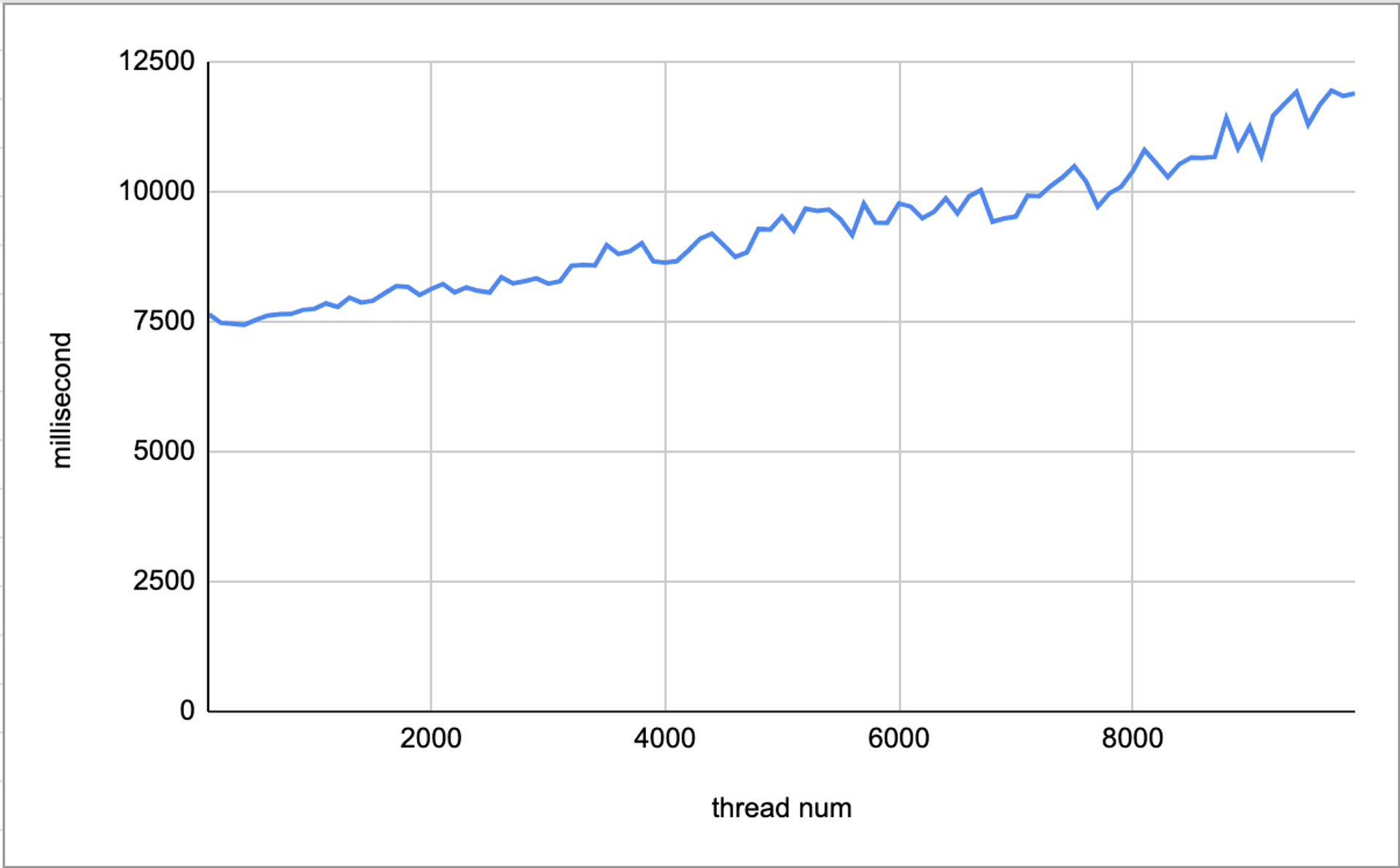
可以看到使用越多 thread 數量越高反而執行時間越久。試著 profile 程式可以看到當 thread num 為 100 時,cpu 花在 doSomething 的時間佔比約為 51%,如下:

而當 thread num 為 9900 時,doSomething 的 cpu 佔用時間比例驟降到 27%。
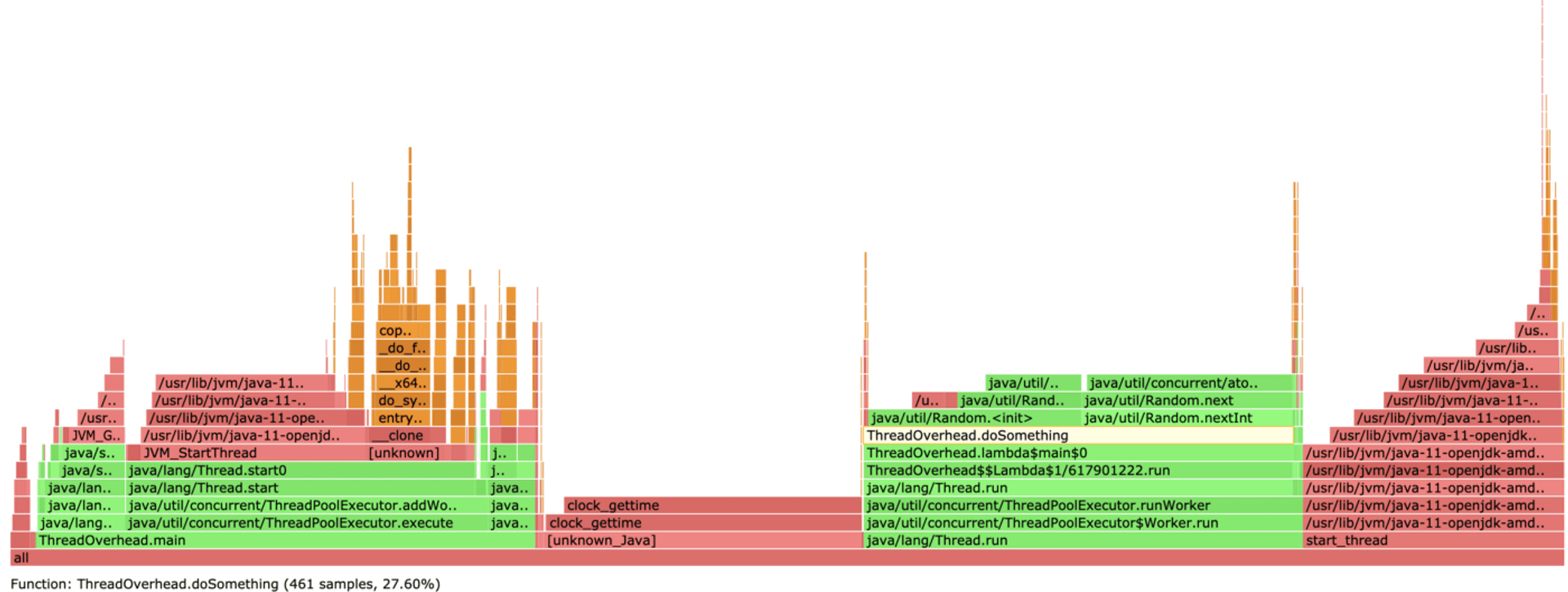
種種跡象都告訴我們,thread 昂貴的開銷,讓 Java 在高併發的場景是略顯無力的。
# Goroutine 怎麼做?
相較 Java 使用 native thread,依賴 OS 原生的 scheduler 去調度,goroutine 實作自己的 scheduler,自行調度 goroutinue 在固定的 thread 間執行:
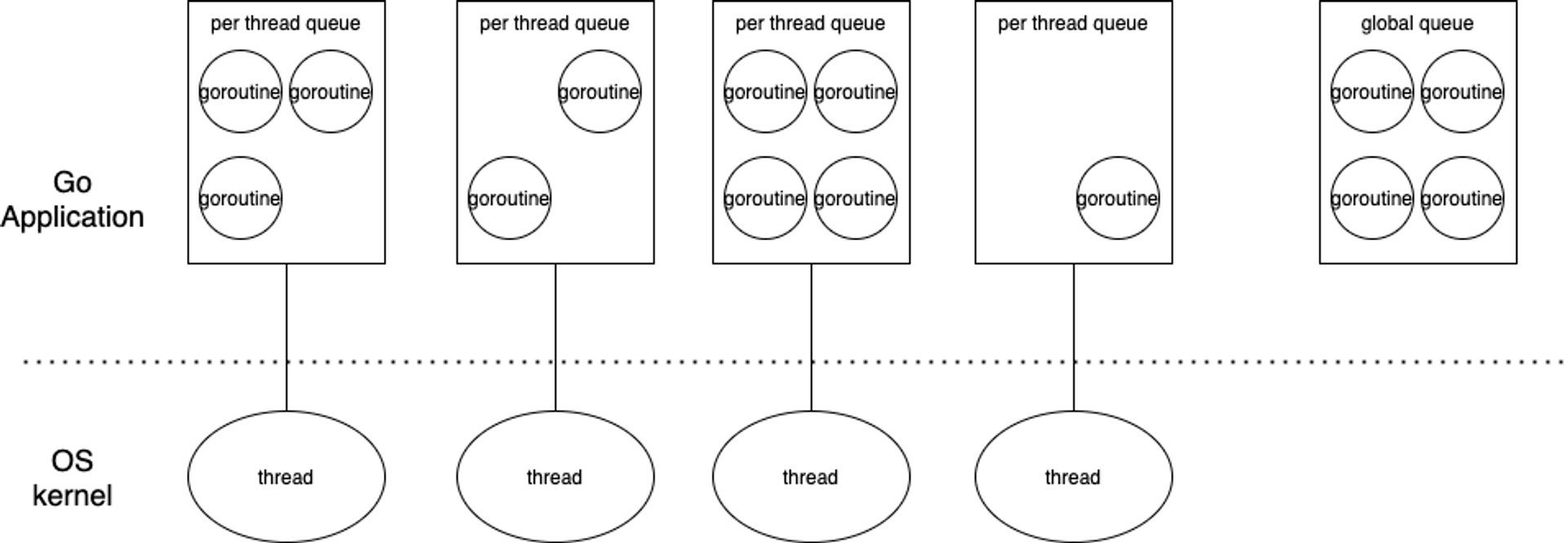
Thread 大約每執行一個 goroutine 10ms 就會切換到另一個 thread。而 thread 挑選 goroutine 的優先順序為
- 每個 thread 各自的 queue 中的 goroutine
- global queue 中的 goroutine
- 從其他 thread 的 queue 竊取 (work-stealing)
Golang 用 GOMAXPROCS 這參數決定 gouroutine 使用多少 thread,預設是 core 數量。
實際看一下在 linux 上跑 goroutine 的 thread 數量,下面是執行的 golang code:
func doSomething() {
time.Sleep(10 * time.Minute)
}
func main() {
for i := 0; i < 100000; i++ {
go doSomething()
}
time.Sleep(10 * time.Minute)
}實際在我的開發環境觀察 thread 數量都在 4~6 左右。
**g7@g7test1**:**~**$ ps -T 1013506 | wc -l
5# Goroutine 的記憶體
一開始創建 goroutine 時會先分配 4k 的記憶體,隨著 goroutine 使用量會動態擴展。相較 Java 的 thread 模型,golang 會比較難被記憶體大小限制著上限。
# Blocking System Call
目前為止看起來很美好,但如果 thread 被 blocking system call 卡住呢 (ex. 讀大檔案)?例如下圖有三個 goroutine 透過 io system call 讀大檔案,此時會導致全部的 goroutinue 只依賴一個 thread 執行,大幅減少 core 的利用率。
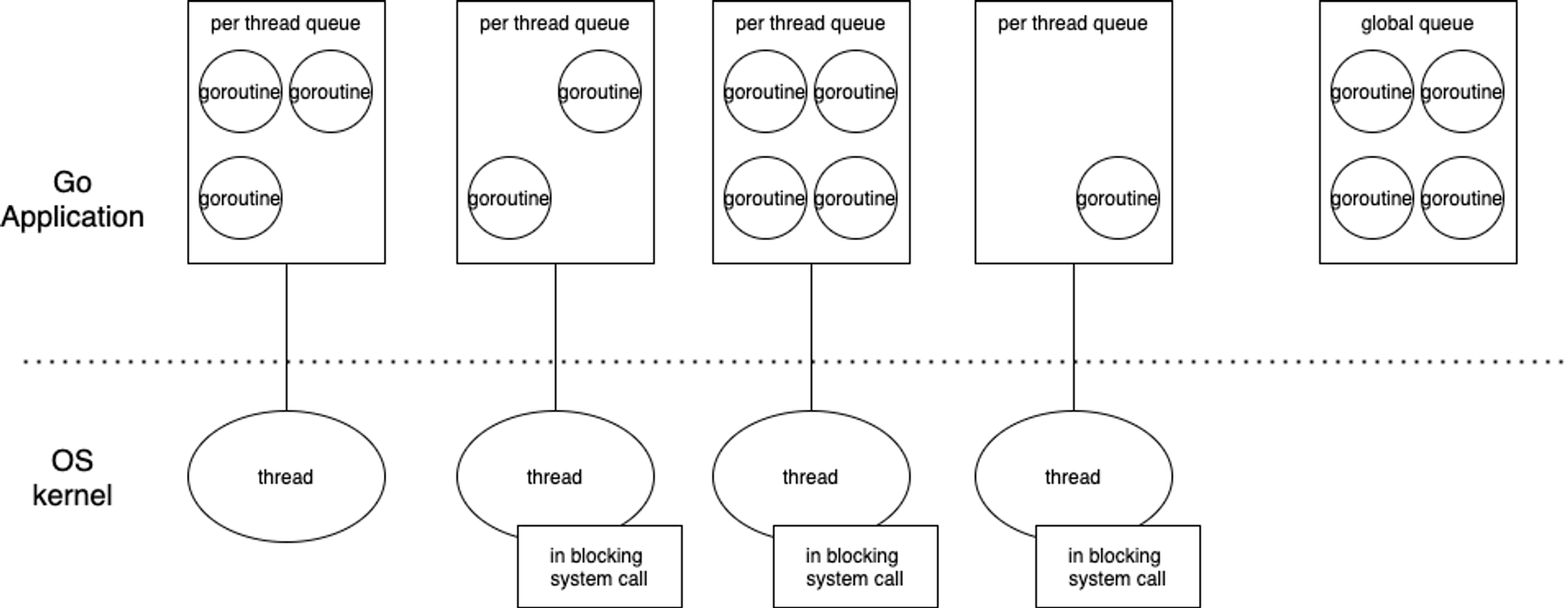
為了解決這問題,golang 在 thread 和 goroutine 間再隔一層 process 如下:
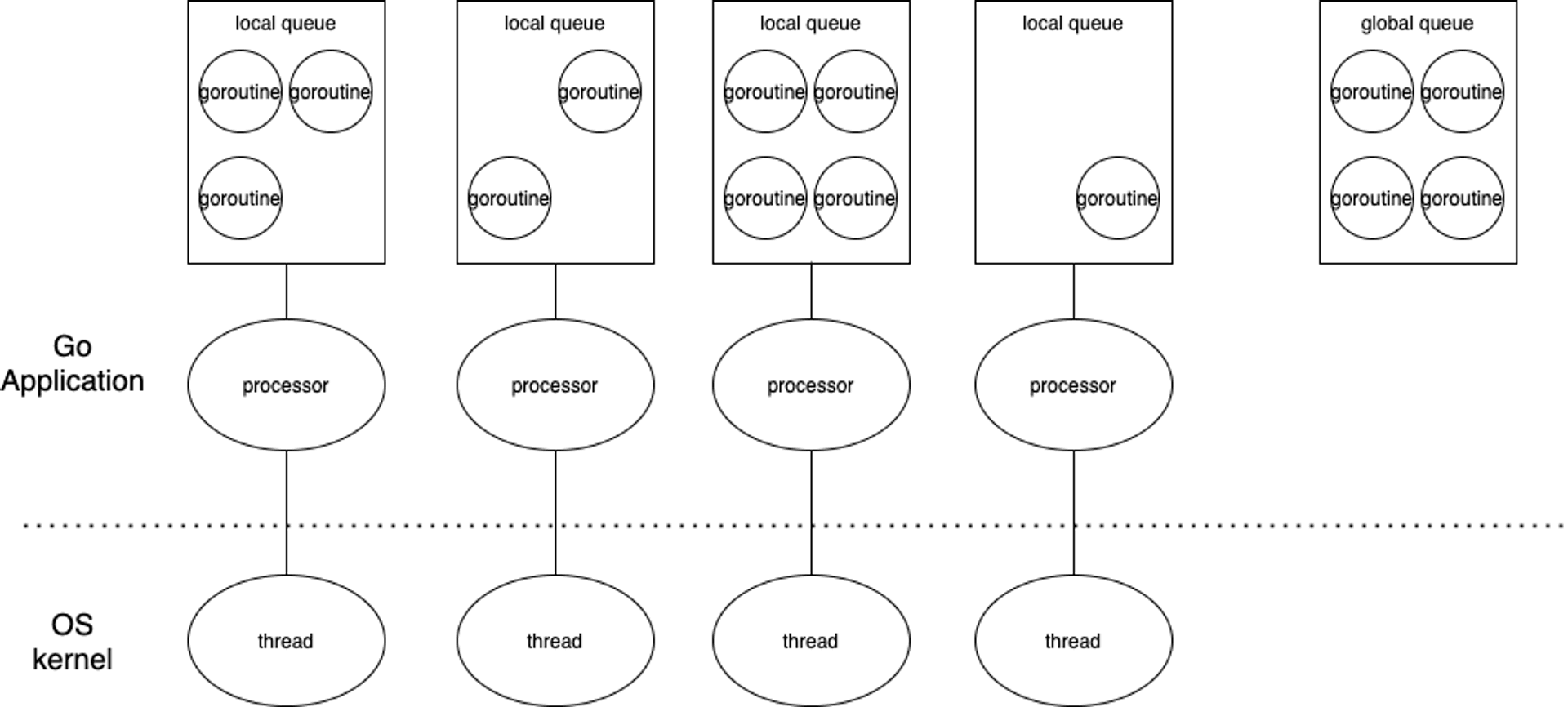
而當有 thread 被 system call block 住時,golang 會另外創建新的 thread 接手該 processor 的工作,而原本的 thread 則繼續執行 system call。
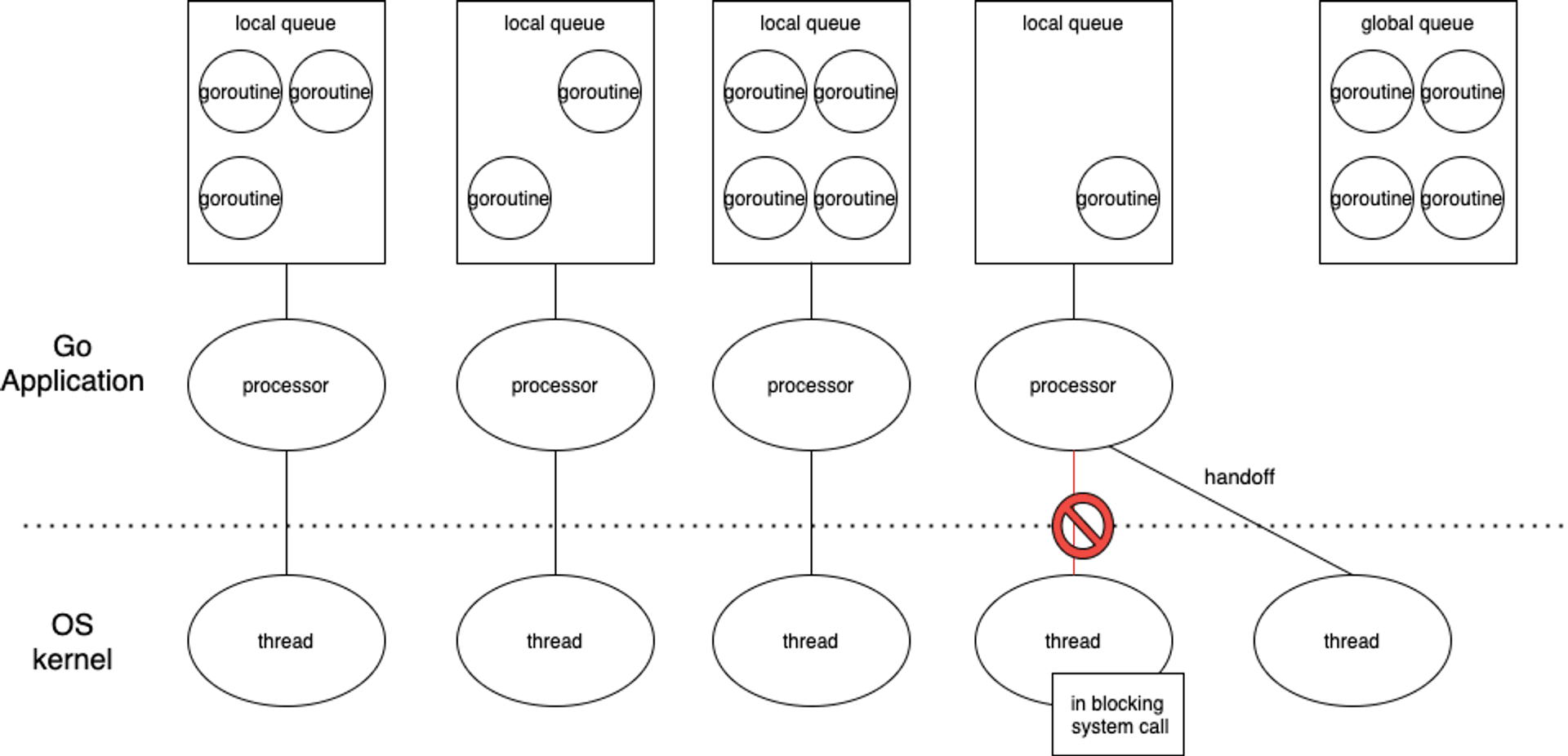
實際用下面的 code,開 1000 個 goroutine 讀大檔案測試:
func readBigFile() {
fi, err := os.Open("bigfile")
if err != nil {
panic(err)
}
defer fi.Close()
buf := make([]byte, 1024)
for {
n, err := fi.Read(buf)
if err != nil && err != io.EOF {
panic(err)
}
if 0 == n {
break
}
}
}
func main() {
for i := 0; i < 1000; i++ {
go readBigFile()
}
time.Sleep(10 * time.Minute)
}跑起來以後觀察該程式啟動的 thread 會增加到 1xx:
**g7@g7test1**:**~**$ ps -T 1013506 | wc -l
142由此我們也可以知道,當 Golang 頻繁開 goroutine 去 call blocking system call 時,其併發量可能會退化到 Java 使用 native thread 一樣。
如果你想更深入了解 goroutine scheduler,可以參考 Go scheduler: Implementing language with lightweight concurrency。
# 結論
目前為止我們討論了 Java 如何實現併發和面臨的問題,以及 goroutine 如何在解決這些問題。但這不代表 Java 對高併發束手無策。
實際上目前 Java 有個 Loom Project,就是要在 JVM 上實作類似 goroutine 機制的 virtual thread。或許在下一個 Java 的 LTS 版本,我們就能在 Java 上感受 Goroutine 輕巧。
題外話,我個人覺得比較有趣的點是 Java 1.2 前 Java 的 thread 設計其實跟 goroutine 很像,是在 OS thread 上跑 Java thread,但在多核心的環境遇到一些效能問題才在 Java 1.3 以後改為使用 native thread。但隨著時代演進,Java 又要改回在 thread 上跑 thread 的設計。
讓我不禁想:會不會未來有一天 OS 有原生類似 goroutine 的機制以後,各大語言又會又轉而改使用 OS 原生的併發機制呢,而不使用自己實作的 scheduler 呢?
Discussion(login required)